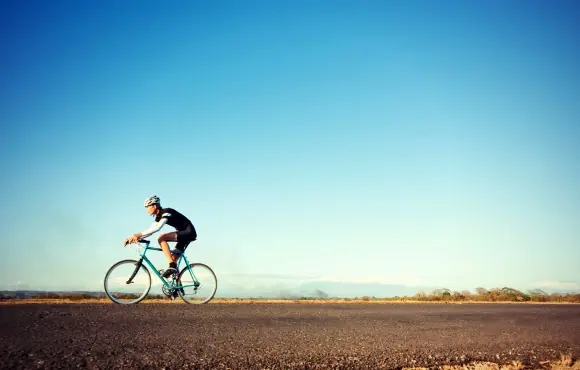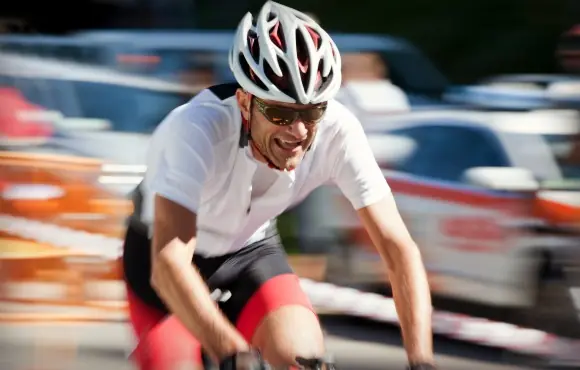Here are nine common mistakes cyclists make and what you can do to correct them.
1. Going Solo
1 of 10
While novice riding skills and a penchant for short rides around the park might make you bashful about showing off your pedaling power—or lack thereof—riding by your lonesome is one of the most fundamental mistakes a new cyclist can make.
Cyclists are an inclusive bunch—well, some are—and asking to join experienced riders on one of their recovery days can be very beneficial. You'll find that riders who have literally been around the block a few times contain a wealth of knowledge that they're eager to share. This is a great way to find a mentor who will happily guide you on your way to becoming a better cyclist.
Find
Cycling Events2. Keeping Your Belly Empty
2 of 10
Exhaustion rarely breeds hunger, which is counterintuitive since your greatest source of energy is just that: food. What food is to cyclists, gasoline is to cars, so be sure to keep your tank full as you tackle longer rides.
This means you'll have to practice eating while you ride. But, if you have the ability to walk and chew gum at the same time, cycling and munching on an energy bar should be right up your alley. The most difficult part is unwrapping your packaged energy bars and peeling bananas but, with plenty of practice, it shouldn't be any different from snacking at your desk.
Find
Cycling Events3. Refusing to Rest
3 of 10
If your ambitious training plan includes riding a hard 50 miles every day of the week—while certainly admirable—you won't see the improvements you desire. Believe it or not, resting is just as important to your improvement on the bike as training.
If you tackle a long, hard ride, and the following couple of days you're tired, this is your body recuperating. And while your body recuperates, it's also improving. You never want to short-change this improvement by going out for another long ride. According to Bicycling Magazine's New Cyclist Handbook, "The ability to make yourself rest when you're tired separates smart riders from those who never seem to make much improvement."
Find
Cycling Events4. Giving it Your All. Every. Single. Time.
4 of 10
Just because you're pedaling doesn't mean you have to pedal hard. In fact, you should keep most rides at a steady 65 to 80 percent of your maximum heart rate, which will keep you rested for moments that require harder efforts.
According to the New Cyclist Handbook, keeping your pace slow burns fat, increases aerobic capacity, and speeds recovery from harder workouts. As a general rule of thumb, if you're having difficulty keeping a conversation with your fellow riders, you need to slow down.
Find
Cycling Events5. Not Using a Heart Rate Monitor or Tracking Your Rides
5 of 10
We're fortunate enough to live in an era when heart rate monitors and GPS units come in tiny, svelte packages.
Fitbit, Garmin, Polar and numerous other brands make devices that measure heart rate, speed and distance. And smart phone apps like Strava or bike computers are great ways to track your rides and keep tabs on your improvement. If you're not already, take advantage of this technology absent a mere 10 years ago, as it will serve as motivation and keep you aware of your progress.
Find
Cycling Events6. Avoiding Dirt
6 of 10
According to the New Cyclist Handbook, "Riding off road is an easy way to improve your bike handling. It increases your climbing power and gives you a break from traffic." So why not consider trading your slicks for knobbies and trying your hand at the trails?
Nearly every serious cyclist rides on any type of terrain, and gravel grinders are all the rage right now. Find one in your area and sign up.
Find
Cycling Events7. Only Riding
7 of 10
To get better at cycling you must ride a bike. Simple enough, right?
While you can't argue against higher mileage, there are other things an aspiring roadie can do to improve. Running, skating and hiking are all great activities that can cut the monotony of being saddled on a bike while working out those ever-important leg muscles and keeping your cardio in check.
Find
Cycling Events8. Following a Rigid Schedule
8 of 10
If you're gearing up for a century ride, following a specific training schedule can be effective. However, obsessive rigidity and pressure to complete specific training rides on specific days can take the fun out fast.
Don't be afraid to break from your training plan and ride like you feel. Just hopping on the bike and getting some miles under your belt is better than not riding at all, and once you're out there you might get a sudden itch to sprint for an upcoming road sign or climb a nearby hill you've been avoiding.
Find
Cycling Events9. And Speaking of Avoiding Hills...
9 of 10
While you might be inclined to walk your bike up that nasty 11 percent grade and saddle up for the wickedly awesome descent, you are effectively stunting your improvement.
On your next ride, take a hillier route and avoid any tempting detours. According to the New Cyclist Handbook, "A stiff climb boosts your heart rate into the stratosphere with little mental effort. It's much easier to hit 90 percent of max on a climb than when time-trialing on the flats." And you wonder why the pros choose to ride in Colorado all the time.







Discuss This Article